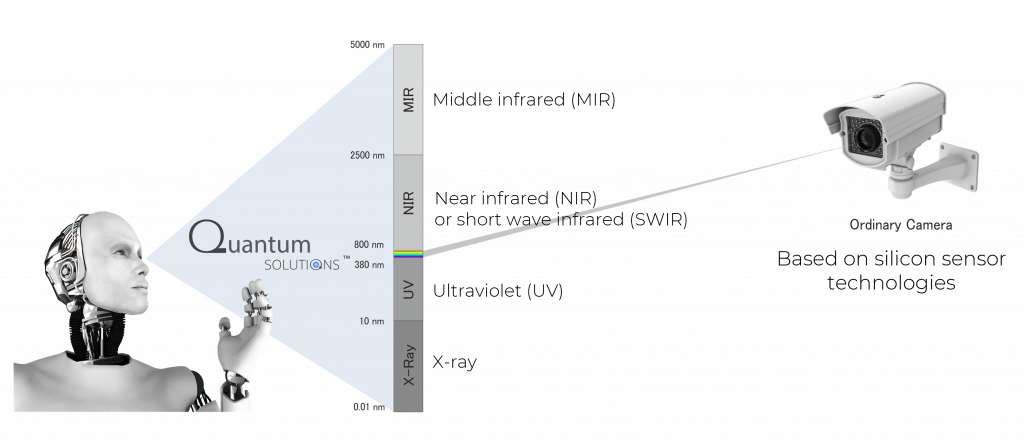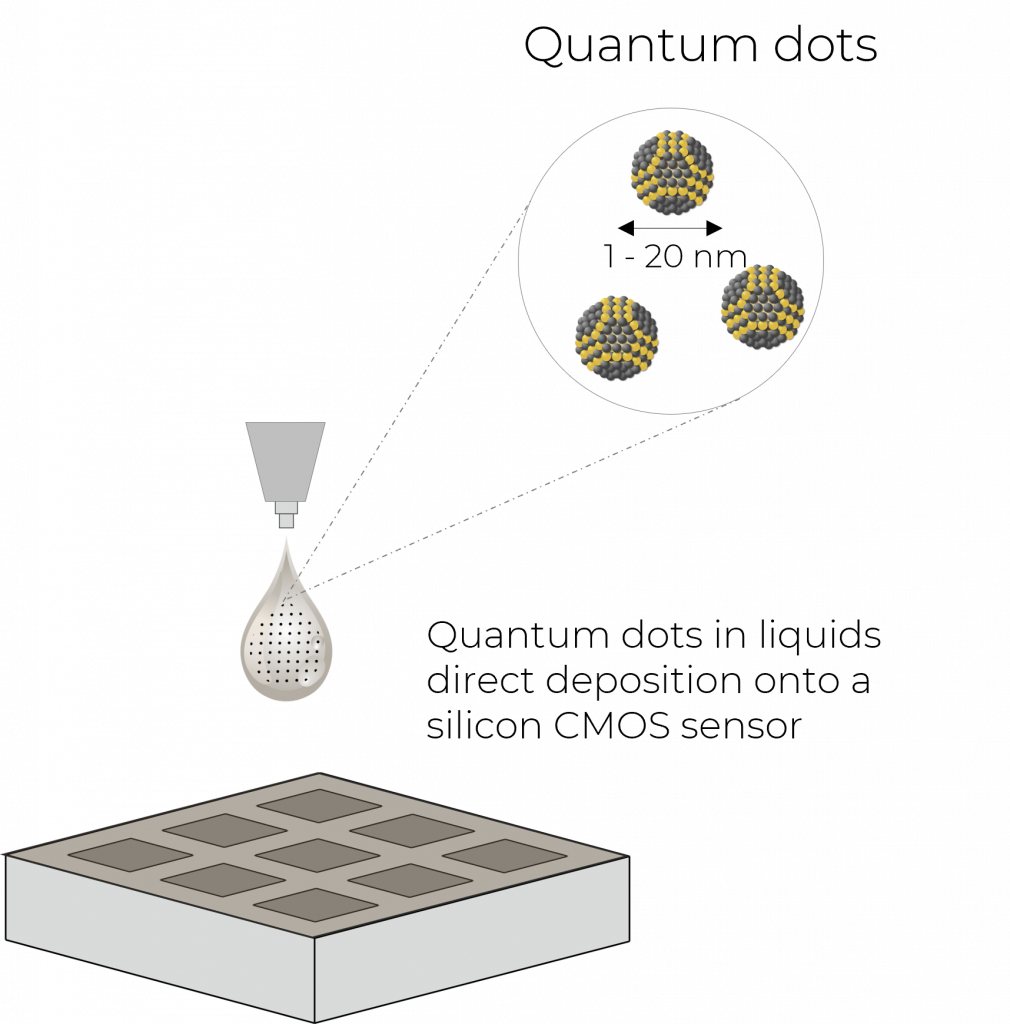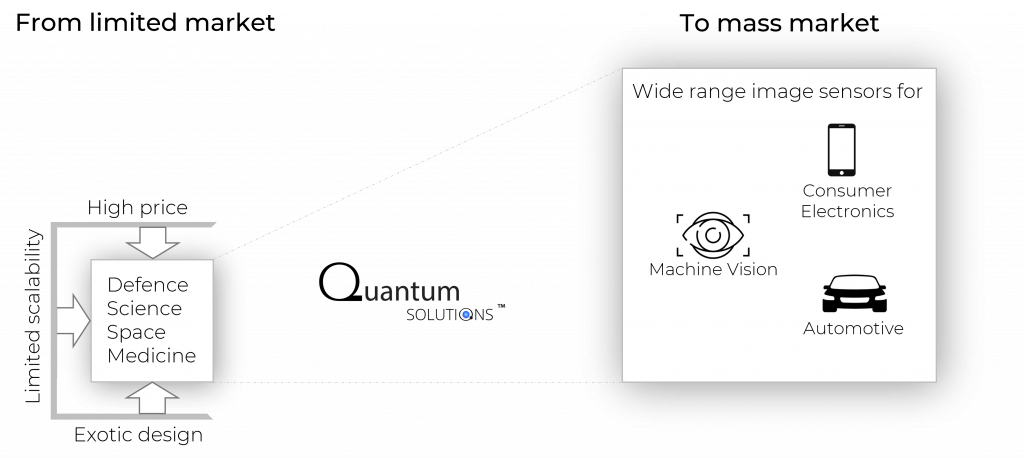The Future is in Sight
QUANTUM DOTS AND THE REVOLUTION OF IMAGE SENSORS
As modern technology evolves, the requirement for ‘wide range image sensors’ continues to grow. Whether it is for consumer technology, automotive machinery, manufacturing, or surveillance applications – a vast number of industries are looking to sensor technology to provide the vision that will facilitate their development…
What are wide range image sensors?
Wide range image sensors offer a level of visibility that cannot be achieved by conventional cameras. Most normal cameras use ‘silicon’ sensors and operate in a visible light range (300-800 nm – which is similar to that of the naked eye), whereas cameras using wide range image sensors have a significantly broader range of light sensitivity. These sensors enable cameras to operate in various ranges including near infrared (NIR) range (800-2500nm, or it might be called short wave infrared (SWIR)), middle infrared (MWIR) range (2500-8000 nm), ultraviolet (UV) range (10-380 nm) and X-ray range (0.01 – 10 nm).

A sensor with SWIR sensitivity can clearly capture images in environments with low to no light (‘night vision’). In this range, objects can also be seen through obstructions that may exist, (such as smoke, fog, mist or vapours).
Wide range image sensors which are sensitive in the MWIR range, are able to capture gas leaks or CO2 pollution and can even be used to monitor and control the flow of toxic gases in chemical or manufacturing plants, through a molecular vision.
Wide range image sensors can even reach ranges that allow for 3D tomography scanning, which essentially enables cameras to display the inside of solid objects through X-rays.
Utilising a range of light sensitivity as broad as this allows cameras to adopt a ‘superhuman vision’ that can create huge potential for use in a vast array of different industries.
The challenges of wide range image sensors
Whilst wide range image sensors are currently available on the market, they are problematic in many ways. Firstly, the fabrication process is incredibly complicated. To capture the different ranges of light beyond visible, special semiconductor materials are used, such as InGaAs for SWIR light, CdZnTe for X-rays or HgCdTe for MWIR light, etc. These semiconductor materials are grown on specialised substrates to form a pixelated array. In order to read a signal from this array, each pixel should be connected with the corresponding pixel from a silicon CMOS (complementary metal-oxide-semiconductor) readout. This is an extremely time-consuming process, known as hybridization and is carried out by forming thousands of solder bump bonds between each pixel. Consequently, the product is sold at a very high price from $10k to as high as $150k or more.

The complicated architecture and development process of these sensors also means that mass production is extremely difficult, and as a result, less than 100,000 units are made annually. In addition, these sensors are only able to capture images at a very low-resolution – below one megapixel – a resolution that is well below the requirement of many industries.
Quantum Dots – The ultimate sensor solution
Quantum Solutions has developed quantum dot technology that eliminates the complicated fabrication process used in wide range image sensor manufacturing, whilst increasing efficiency, and solving many of the fundamental challenges that these sensors present.
The use of quantum dots allows us to avoid the time-consuming hybridization step in the fabrication process, meaning sensors can be manufactured in vast quantities. Because the manufacturing process is simplified and mass-production is possible, the sensors are at least 10-100 times less expensive and can therefore be more readily available to many new industries. Quantum dots also allow for images to be captured at a much higher resolution, as they significantly improve efficiency, enabling cameras to create images of up to 10 megapixels.
How do quantum dots work?
Quantum dots are nanoparticles of semiconductor materials ranging in sizes from 1nm to 20nm. (Click here and here to learn more about quantum dots). The size and composition of a quantum dot means we are able to control or manipulate them with great precision throughout the manufacturing phase and fabricate the sensor with a particular sensitivity range starting from X-ray up to MWIR range. At this stage, varying levels of sensitivity can be developed, depending on particle composition and size. The size and composition can be altered, which allows us to develop products for each of the different sensor requirements, so if there is a requirement for a SWIR, MWIR, UV or X-ray camera sensor, we are able to create different compositions for each respective range of light sensitivity.
Quantum dots have the same optical properties as the semiconductors that are used in wide range image sensors, but they have a very important advantage. They can be dispersed in a liquid form which means that they can be simply printed and deposited on top of a silicon CMOS readout. Their compatibility with conventional silicon circuits means that the complicated manufacturing process is completely avoided.

By using quantum dot technology, an affordable, more efficient and easily manufactured alternative is produced.
The limitless benefits of Quantum Dot technology
Currently, the cost and general limitations of manufacturing wide range image sensors means that the technology is limited to a very small number of niche applications. However, quantum dot technology can change that, allowing limitless industries to embrace the benefits.

The use of wide range image sensors using quantum dot technology will potentially enhance applications such as machine vision, with a new level of intelligence through increased flexibility, autonomy, and efficiency in industrial automation. This will improve both productivity and safety in industrial environments.
For example, SWIR sensors (click here and here to learn more) are used for quality control, to identify defective or abnormal products. The technology can also be used in food processing, to identify any failings or irregularities. It can also be used to assess the quality in many other areas of manufacturing, by monitoring patterns of structure or irregularities in appearance or composition.
Quality control can also be enhanced through X-ray vision, allowing for high-definition imaging that facilitates an assessment of internal defects and the detection of irregularity in the engines of cars, for example. The same method can also be used in medical environments for patient examinations with low X-ray dose and high precision.
Consumer electronics ranging from mobile devices, VR and AR technology, wearables, (and any other technology that brings the physical and digital world together), will soon rely on high performance SWIR sensors to develop and progress. Quantum dots have the potential to make sensors for such consumer tech more efficient, affordable, and accessible.
The development of self-driving cars also relies on wide range image sensors, such as SWIR sensors, as the vehicles will be dependent on maintaining vision through adverse conditions such as fog, dust/smoke, mist, and rain, as well employing distance awareness for the safety and comfort of passengers. These sensors can also enhance automotive LiDAR and ToF (time-of-flight) sensors to provide ten times more accurate and reliable 3D imaging and mapping than silicon cameras.
The list of applications that can benefit from Quantum Solutions technology are endless, but just a few other areas include security, surveillance, military, agriculture, environmental technology, information storage, pharmaceuticals, biomedical imaging – to mention just a few.
In summary, quantum dot technology has the potential of removing many boundaries that currently exist in creating wide range image sensors. As well as offering affordability and mass production, quantum dots will open doors for countless applications, allowing many industries to utilise them. As a revolutionary approach with vast potential, quantum dots can help facilitate the technological progression of limitless fields.
